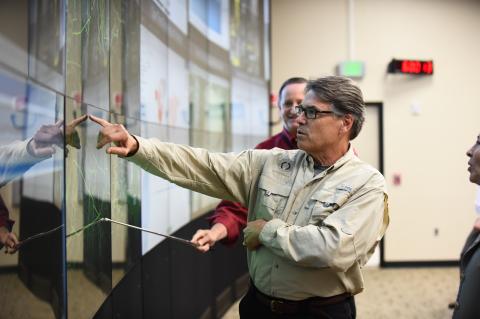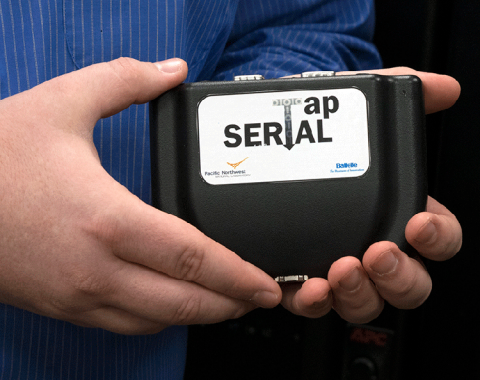PNNL Protecting the Electric Grid From Cyberattack

PNNL's Electricity Infrastructure Cybersecurity and Resilience Center serves as a hub of grid cybersecurity work at PNNL, ready to support several federal entities, as well as electrical utilities. Researchers include Michael Mylrea, Lori Ross O'Neil and Paul Skare.
(Photo by Andrea Starr | Pacific Northwest National Laboratory)
We depend on electricity for nearly everything we do.
Flip a switch, and the lights come on. Turn up the thermostat, and the room gets warm.
Pre-heat the oven and start preparing the Thanksgiving turkey, or microwave the leftovers.
Electricity is essential to our quality of life, our well-being and our energy-dependent economy.
Researchers at the Department of Energy's Pacific Northwest National Laboratory are working with industry, academia and municipalities to ensure that electrons continue to flow reliably and securely to our homes and businesses.
To do this, we are developing and delivering new technologies and approaches to better measure, analyze, predict and control the electric power grid.
Along the way, we also are looking at ways to protect it from all kinds of risks, including cyberattacks.
Just last month, one of our experts testified before Congress about advanced cybersecurity technologies. He shared details of how a voluntary information-sharing program among industry and the government allows a broad view of cyber threats across the system.

Analyzing the collective data makes it possible to quickly alert utilities of potential vulnerabilities.
Our researchers are expanding this "cybersecurity situational awareness" to develop an integrated, real-time view of utilities' cyber risks.
Beyond identifying risks to information technologies, they also are looking at risks to operational technologies, such as internal grid control system. Their efforts combine high-performance computing and machine learning techniques to analyze and spot trouble in the vast data streams generated by the growing number of intelligent devices on the grid.
By quickly identifying trends and relationships in the data that may reveal a potential threat, grid operators and automated protection systems can rapidly take action to protect the grid.
PNNL is also conducting research and developing technologies for the future defense of the grid. In a testament to the lab's strength in this area, DOE recently selected us to lead six of 20 new grid cybersecurity research projects.

One of these projects aims to ensure the security of real-time information exchanges that will occur as new technologies are introduced to the "smart" grid. One such exchange might involve the use of transactive controls, where financial signals influence how and when energy is used.
Another information exchange might relate to how distributed resources, such as boxcar-sized batteries or intermittent solar and wind power might come on and off the grid as needs and availability vary.
To protect these information exchanges, this project will enable a shift from digital signatures and encryption to a "keyless" solution. Much of today's grid information security is based on technology akin to using a set of master keys to open all the doors across a large business complex.
Consider the inherent risk in managing access to the master keys: what happens if a set is compromised, how do we get the keys back when someone leaves, and how do we add a building with incompatible locks?
The keyless infrastructure solution being investigated will continuously monitor and autonomously verify the integrity of complex transactions—and do so with the security, speed and scale needed for the grid of the future.
While this project focuses on existing systems, another seeks to build a partnership among suppliers and end users of energy to improve the security of new products before they ever go to market.
These examples give just a glimpse of PNNL's research and development to create a more secure and resilient power grid.
We are working hard to ensure that lights will continue to come on with the flip of a switch—and that your oven (and microwave) is ready for the Thanksgiving turkey.
The stuffing is up to you.
Steven Ashby, director of Pacific Northwest National Laboratory, writes this column monthly. To read previous Director's Columns, visit pnnl.gov/news and filter by Director's Columns in our Latest Stories.
Published: November 26, 2017